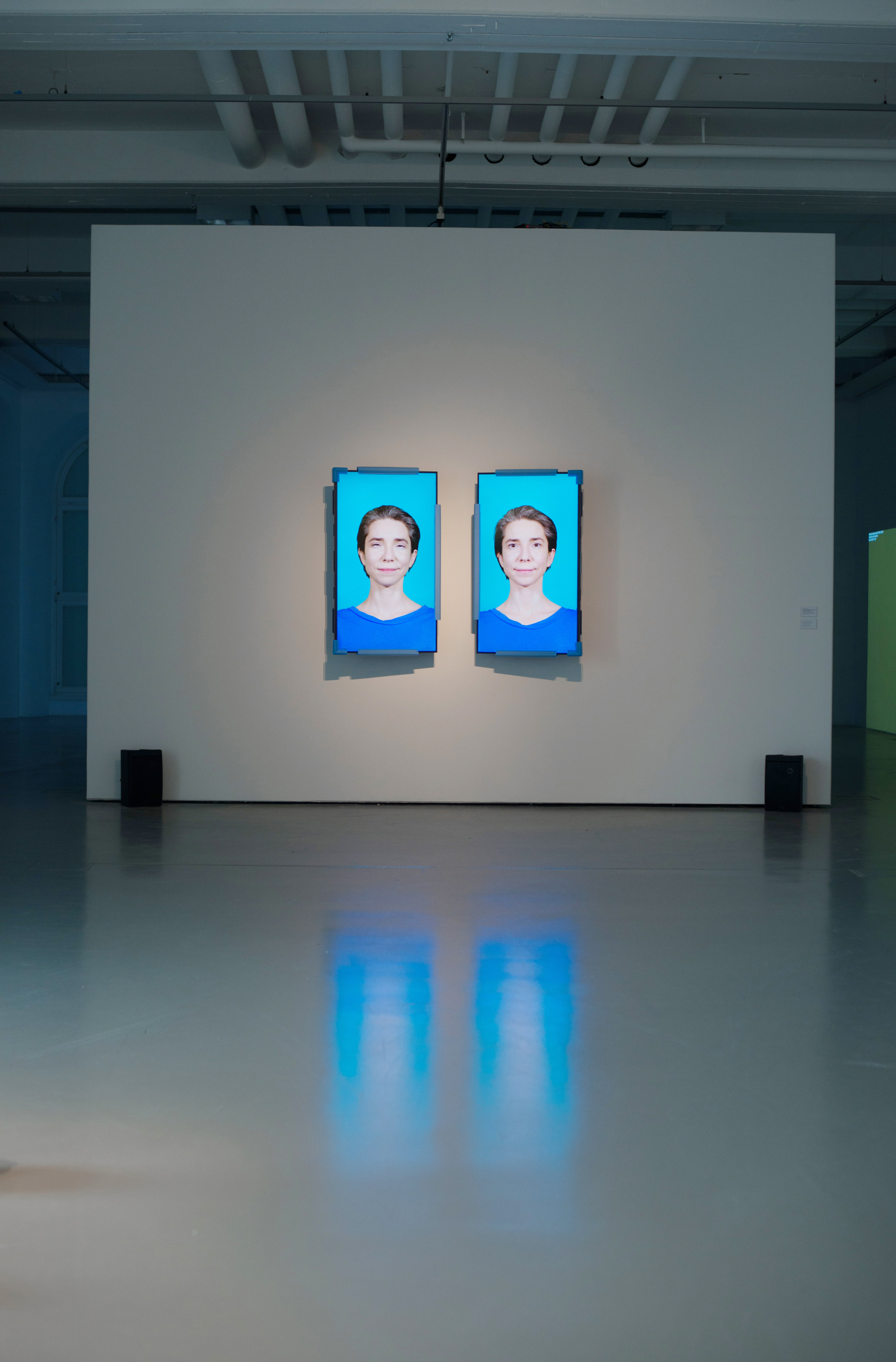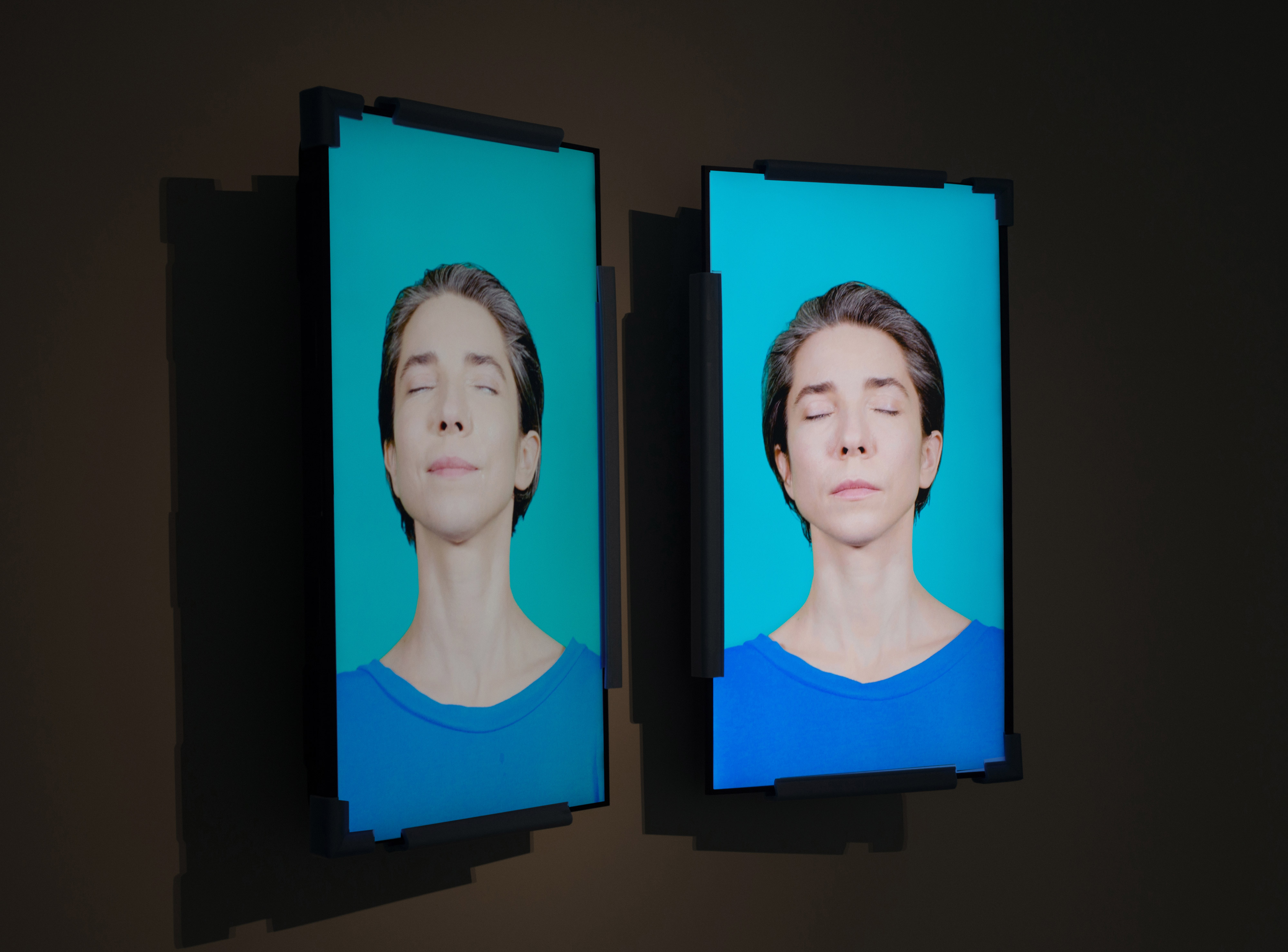Interface (A research on emotions by pattern recognition)
2018

In this two channel video work a movement analysis of emotions is being done by deconstructing it into temporal segments that produced the expression, called action units (AU – developed by prof. Paul Ekman and used in most emotion recognition software). On one screen emotions are being expressed by actress Marina Miller Dessau – hereby she reacts on stories being told to her. On the right screen the observed components of facial movements are re-enacted the day after.
The result is a non verbal exchange between computerized movements and their corresponding emotions, in which the detection technique is triggered by the emotions but also the other way around.
Two channel 4K video, 23 minutes loop. 55 inch, polyethylene foam, Double Arm Flat Screen Wall Mount
Credits:
Actress: Marina Miller Dessau
Choreography: Marjolein Vogels
Sound design: Arnoud Traa
Percussion: Onno Govaert
Technique: Joerg Drefs, Sylvian Vriens
Camera: Tim Nowitzki
make up: Rafaela Siqueira
Software: Facereader by Noldus
This project is generously funded by Creative Industry Fund (NL), EMARE grant. And supported by Werkleitz Gesellschaft. The emotion software is FaceReader, with the help of the Usability Lab, Communication and Multimedia Design, Amsterdam University of Applied Science
‘Vogelaar’s research projects often result in multiple works. Interface, a Research on Emotions by Pattern Recognition (2018), for instance, is another outcome of her interest in the Facial Action Coding System. In this work, one screen again showed Milena Miller Dessau, this time reacting with free facial associations to stories that were being told to her. She did this by using the improvisation technique Authentic Movement, developed by the dancer Mary Starks Whitehouse in 1950. The other screen showed the computer-observed components of those same facial movements, aka AU’s, re-enacted on the basis of instructions. Spectators could experience Interface via a two-channel video installation that resulted in a non-verbal game of ping-pong between the computerised movements and their corresponding, real-life emotions. That comparison made it quite obvious that both human and computer had an extremely fragmented outlook on the world – neither of them able to focus on more than one thing at a time.’
Dagmar Dirkx, Noise is an Asset, Prix de Rome exhibition
The result is a non verbal exchange between computerized movements and their corresponding emotions, in which the detection technique is triggered by the emotions but also the other way around.
Two channel 4K video, 23 minutes loop. 55 inch, polyethylene foam, Double Arm Flat Screen Wall Mount
Credits:
Actress: Marina Miller Dessau
Choreography: Marjolein Vogels
Sound design: Arnoud Traa
Percussion: Onno Govaert
Technique: Joerg Drefs, Sylvian Vriens
Camera: Tim Nowitzki
make up: Rafaela Siqueira
Software: Facereader by Noldus
This project is generously funded by Creative Industry Fund (NL), EMARE grant. And supported by Werkleitz Gesellschaft. The emotion software is FaceReader, with the help of the Usability Lab, Communication and Multimedia Design, Amsterdam University of Applied Science
‘Vogelaar’s research projects often result in multiple works. Interface, a Research on Emotions by Pattern Recognition (2018), for instance, is another outcome of her interest in the Facial Action Coding System. In this work, one screen again showed Milena Miller Dessau, this time reacting with free facial associations to stories that were being told to her. She did this by using the improvisation technique Authentic Movement, developed by the dancer Mary Starks Whitehouse in 1950. The other screen showed the computer-observed components of those same facial movements, aka AU’s, re-enacted on the basis of instructions. Spectators could experience Interface via a two-channel video installation that resulted in a non-verbal game of ping-pong between the computerised movements and their corresponding, real-life emotions. That comparison made it quite obvious that both human and computer had an extremely fragmented outlook on the world – neither of them able to focus on more than one thing at a time.’
Dagmar Dirkx, Noise is an Asset, Prix de Rome exhibition



Installation view: Exhibition Monitoring, Kassel Museum Fridericianum


Supported by Creative Industry Fund (NL), EMARE grant, Werkleitz Gesellschaft
